In the World Development Indicators, all 189 World Bank member countries, alongside 28 others with populations exceeding 30,000, are categorized by income level and geographic region for presenting key statistics. This facilitates users to aggregate, group, and compare statistical data as necessary.
Noteworthy classifications encompass geographic regions, income groups, and operational lending categories of the World Bank Group, periodically updated, with the latest versions available here.
The term country, synonymous with economy, doesn't denote political independence but rather refers to any territory for which authorities report separate social or economic statistics.
Income Groups:
Economies are presently segmented into four income groupings: low, lower-middle, upper-middle, and high. Income is gauged using gross national income (GNI) per capita, in U.S. dollars, converted from local currency via the World Bank Atlas method. GNI estimates are sourced from economists in World Bank country units, with population size estimated by World Bank demographers using various sources, including the UN's biennial World Population Prospects.
Countries are assigned on July 1 each year, based on their Atlas GNI per capita estimate for the preceding calendar year. For instance, the classification released on July 1, 2022, relies on estimates for the fiscal year 2021. Income groupings persist for the entire fiscal year (until July 1 of the subsequent year), irrespective of any revisions to Atlas GNI per capita estimates in the interim.
Geographic Regions:
Groupings primarily align with regions utilized for administrative purposes by the World Bank. Two main variants exist: one encompassing all economies, and one excluding high-income economies.
Operational Lending Categories:
Economies are also categorized into IDA, IBRD, and Blend categories based on the World Bank's operational policies. International Development Association (IDA) countries are those with low per capita incomes lacking the financial ability to borrow from the International Bank for Reconstruction and Development (IBRD). Blend countries are eligible for IDA loans but also for IBRD loans due to their financial creditworthiness.
Reassignments of operational lending categories may occur at any time but are only reflected in World Development Indicators or other databases upon updates.
Other Groupings:
Additional country groupings in World Development Indicators include OECD member countries, countries in the euro area, member states of the European Union, the UN Least Developed Countries classification, and the World.
World Bank Group country classifications by income level for FY24 (July 1, 2023- June 30, 2024)
World Bank Group country classifications by income level
1987
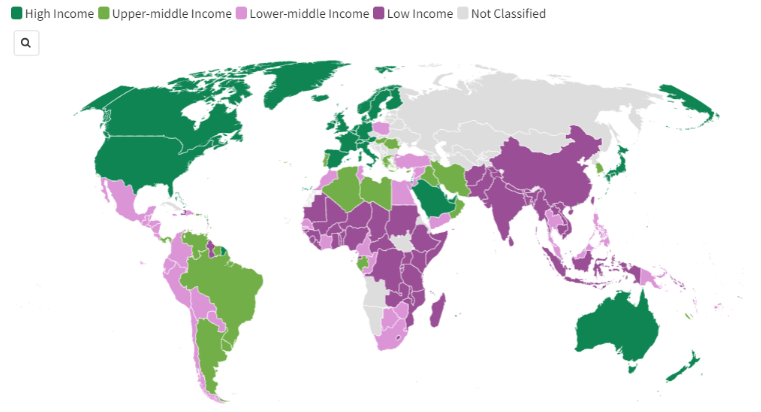
Source - World Bank
2022
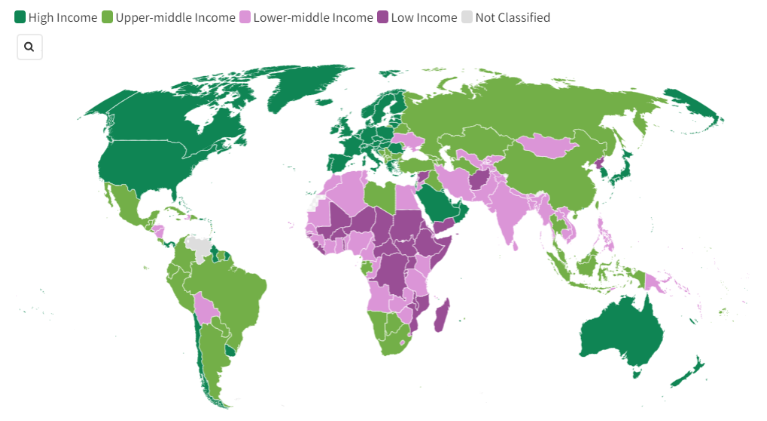
Source - World Bank
The World Bank Group categorizes the world's economies into four income groups – low, lower-middle, upper-middle, and high. These classifications are updated annually on July 1, based on the GNI per capita of the preceding calendar year. GNI measures are denoted in United States dollars using conversion factors derived from the Atlas method, established in 1989.
The World Bank’s income classification seeks to reflect a country’s development level, relying on Atlas GNI per capita as a widely available indicator of economic capacity.
The categorization of countries into income groups has significantly changed since the late 1980s. In 1987, 30% of reporting countries were labeled as low income, compared to 12% in 2022. This decline varied across regions, with Sub-Saharan Africa seeing its proportion of low-income countries decrease from 74% to 46% in 2022, East Asia Pacific from 26% to 3%, and South Asia from 100% to 13% as economies shifted to higher categories over time. The visual depiction below illustrates income patterns by region.
Region wise
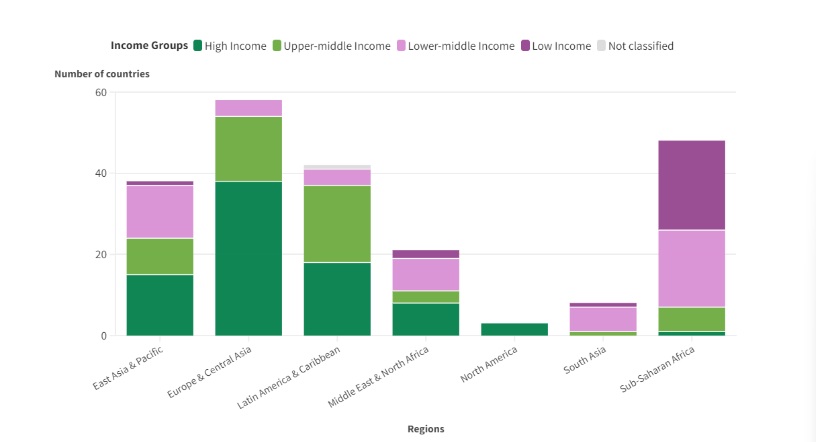
Source - World Bank
Classification changes
From a statistical perspective, classifications can change for two primary reasons:
Changes to Atlas GNI per capita: In each country, factors such as economic growth, inflation, exchange rates, and population growth can all influence the level of Atlas GNI per capita. Revisions to improve methods and data can also play a role. Updated data on Atlas GNI per capita for 2022 can be accessed here.
Changes to classification thresholds: To maintain income classification thresholds at consistent real values, they are adjusted annually for inflation using the Special Drawing Rights (SDR) deflator. This deflator is a weighted average of the GDP deflators of China, Japan, the United Kingdom, the United States, and the Euro Area.
The new thresholds for Atlas GNI per capita are as follows:
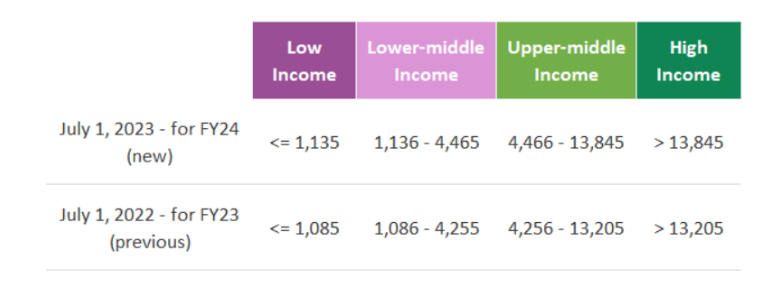
Source - World Bank
Countries changing income category in FY24
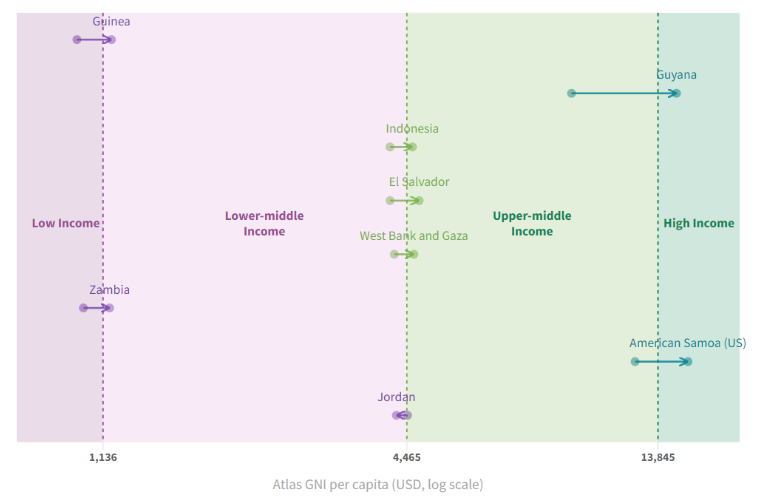
Source - World Bank
Notably, among countries altering their income classifications in 2022, nearly all ascended to a higher category as the recovery from the COVID-19 pandemic persisted. Concerning Atlas GNI per capita, approximately 80% of countries exhibited improvement in 2022 compared to the pre-pandemic period (2019).
This year, both Guyana and American Samoa transition from upper-middle to the high income category. Guyana's notable increase in Atlas GNI per capita stems from a significant surge in oil and gas production, which more than doubled in 2022. Meanwhile, American Samoa's rise in Atlas GNI per capita was primarily due to a substantial downward revision (-18.3%) to population estimates by the United Nations Population Division, reflecting new available data from the 2020 census.
El Salvador, Indonesia, and West Bank and Gaza all hovered close to the upper-middle income threshold in 2021, with modest GDP growth in 2022 propelling these economies into this category. El Salvador experienced 2.6% real GDP growth, while Indonesia continued its robust post-pandemic recovery with a 5.3% increase in real GDP. West Bank and Gaza, following strong post-pandemic growth in 2021 (7.9%), saw a 3.9% growth in 2022, sufficient to cross the threshold into the upper-middle income category.
Guinea and Zambia both advanced from the low income to the lower-middle income category this year. Despite facing political instability and supply disruptions in agriculture, Guinea's economy expanded by 4.7% in 2022, fueled by a robust mining sector. Zambia's economy also grew by 4.7% in 2022, accompanied by an 8.6% inflation rate (measured by the GDP deflator), resulting in a 17.7% increase in nominal GNI and a 13.6% rise in Atlas GNI per capita.
Jordan was the sole country experiencing a downward classification change this year, primarily due to a significant upward revision (+8.6%) to population estimates published by the United Nations Population Division, reflecting new data from the latest population census.

